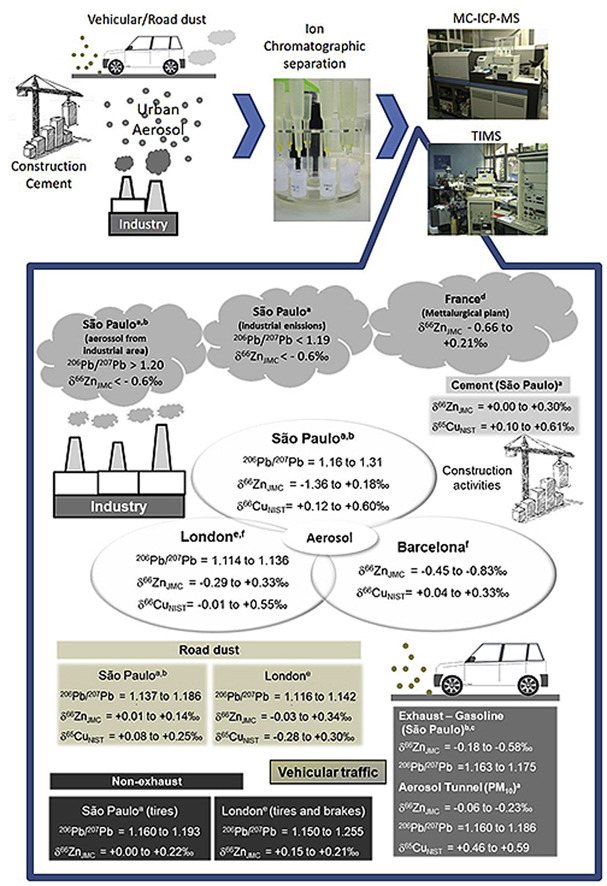 Studies including multiple isotope systems in aerosols promises unparalleled insights into sources and pathways of metals in the atmosphere. However, such studies remain rare because of the challenges associated with small sample sizes and low analyte masses of the target elements. Here, we present the first study combining accurate and precise determination of Pb, Cu and Zn isotopic ratios in aerosols and anthropogenic materials collected in São Paulo, Brazil. We use a sequential ion chromatography procedure with two different resins for the separation and purification of the analytes. Multi collector mass spectrometry is used for the accurate and precise determination of the isotope ratios. Long term analytical reproducibilities are ±0.035 for 206Pb/204Pb, ± 0.13‰ for δ65CuNIST and ±0.1‰ for δ66ZnJMC (±2σ). Accuracy is assessed using certified reference materials (CRM NIST 2783 aerossol, BRP-1 and others). We analyzed 57 source samples (road dust, tires, cement, road tunnel aerosol) and 113 aerosol samples collected between 2013 and 2015. The results for São Paulo are critically compared with previously published data from studies conducted in São Paulo, London and Barcelona. The key findings are: 1. The isotope signatures for Zn in tires (δ66ZnJMC = 0.16 ± 0.14, 2σ, n = 9) and road dust (δ66ZnJMC = 0.17 ± 0.19, 2σ, n = 13) are similar in São Paulo and London suggesting that this isotope system can be used as element specific tracers for non-exhaust traffic. 2. 206Pb/207Pb vs δ66ZnJMC and δ66ZnJMC vs δ65CuNIST multi-isotopic diagrams successfully separate wear off from cars including tires and brakes, car exhaust, industrial emissions and cement sources and improves the discrimination of air pollutant sources. 3. The source identification based on isotope ratios agrees source apportionment based on emissions inventory from these cities. 4. We present Pb, Cu and Zn isotopic data for the first time for the CRM NIST 2783 and BRP-1. These new data will enable future intercalibration and quality controls in other laboratories. Our study confirms that stable isotope ratio analysis have a great potential for element specific source characterization (e.g., separating non combustion traffic sources from combustion sources) for Cu, Zn and Pb.
Studies including multiple isotope systems in aerosols promises unparalleled insights into sources and pathways of metals in the atmosphere. However, such studies remain rare because of the challenges associated with small sample sizes and low analyte masses of the target elements. Here, we present the first study combining accurate and precise determination of Pb, Cu and Zn isotopic ratios in aerosols and anthropogenic materials collected in São Paulo, Brazil. We use a sequential ion chromatography procedure with two different resins for the separation and purification of the analytes. Multi collector mass spectrometry is used for the accurate and precise determination of the isotope ratios. Long term analytical reproducibilities are ±0.035 for 206Pb/204Pb, ± 0.13‰ for δ65CuNIST and ±0.1‰ for δ66ZnJMC (±2σ). Accuracy is assessed using certified reference materials (CRM NIST 2783 aerossol, BRP-1 and others). We analyzed 57 source samples (road dust, tires, cement, road tunnel aerosol) and 113 aerosol samples collected between 2013 and 2015. The results for São Paulo are critically compared with previously published data from studies conducted in São Paulo, London and Barcelona. The key findings are: 1. The isotope signatures for Zn in tires (δ66ZnJMC = 0.16 ± 0.14, 2σ, n = 9) and road dust (δ66ZnJMC = 0.17 ± 0.19, 2σ, n = 13) are similar in São Paulo and London suggesting that this isotope system can be used as element specific tracers for non-exhaust traffic. 2. 206Pb/207Pb vs δ66ZnJMC and δ66ZnJMC vs δ65CuNIST multi-isotopic diagrams successfully separate wear off from cars including tires and brakes, car exhaust, industrial emissions and cement sources and improves the discrimination of air pollutant sources. 3. The source identification based on isotope ratios agrees source apportionment based on emissions inventory from these cities. 4. We present Pb, Cu and Zn isotopic data for the first time for the CRM NIST 2783 and BRP-1. These new data will enable future intercalibration and quality controls in other laboratories. Our study confirms that stable isotope ratio analysis have a great potential for element specific source characterization (e.g., separating non combustion traffic sources from combustion sources) for Cu, Zn and Pb.
Be First to Comment